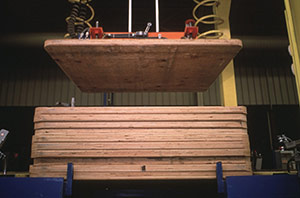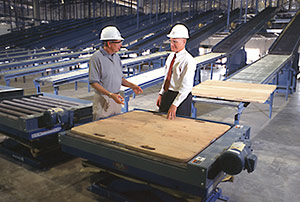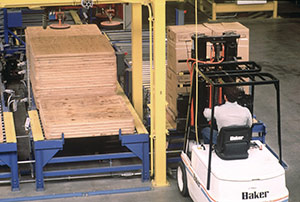Quick Facts:
- Low-profile captive pallets are thick slabs of plywood used in modern automated storage and retrieval systems
- Superior stiffness, dimensional stability, and space-saving design makes plywood captive pallets ideal for automated systems
- An extended lifecycle makes engineered wood pallets the cost-effective choice for the long run ideal for automated systems
The Right Fit for Automated Systems
 As companies continue to modernize their distribution needs, automated storage and retrieval systems are becoming increasing popular. Superior stiffness, dimensional stability, and space-saving design makes plywood captive pallets ideal for automated systems.
As companies continue to modernize their distribution needs, automated storage and retrieval systems are becoming increasing popular. Superior stiffness, dimensional stability, and space-saving design makes plywood captive pallets ideal for automated systems.
Captive pallets, cut-to-size slabs of thick plywood manufactured to particular specifications, are built for use in semi-automated and computer-controlled automated storage systems. Low-profile captive pallets do not have recesses for retrieval fork entry because they are suspended at the edges and never leave the materials handling system.
Plywood Captive Pallets Deliver Advantages
 Plywood captive pallets are an economical, simple and durable solution to many materials handling requirements. They offer the clear benefits of plywood itself: easily adaptable, readily available, dimensionally stable, extremely durable, strong yet light and highly resistant to deflection and distortion. Decades of experience have proven the benefits of plywood captive pallets.
Plywood captive pallets are an economical, simple and durable solution to many materials handling requirements. They offer the clear benefits of plywood itself: easily adaptable, readily available, dimensionally stable, extremely durable, strong yet light and highly resistant to deflection and distortion. Decades of experience have proven the benefits of plywood captive pallets.
Adaptable
Plywood captive pallets can be varied in size and strength to accommodate any fully or semi-automated storage and retrieval system. They can also be easily modified for especially severe uses by a variety of overlays, edge protectors, corners, or special fittings.
Available
Plywood is available in numerous grades and thicknesses, thus allowing the captive pallet designer to tailor the finished product to specific in-service requirements for the most reasonable cost.
Dimensionally Stable
Plywood is dimensionally stable in the plane of the panel when subjected to changing temperatures or moisture conditions. This means that they maintain their shape and hence their long-term usefulness.
Durable
Plywood improves on wood's well-known ability to absorb shock. Its cross-laminated construction helps to distribute impact loads and makes it virtually split-resistant. Plywood holds up well to sharp blows, fork impact and other in-service abuses, which in turn means lower maintenance costs, less down-time and a reduced need for standby pallets.
Strong
By cross-lamination of layers or veneer, plywood provides the inherent along-the-grain strength of wood in both directions. Yet relative to its strength, plywood is lightweight, making it easy to handle, work and install.
Resists Deflection & Distortion
Plywood's excellent stiffness – measured as resistance both to deflection under uniform and concentrated loads and to forces that would tend to distort the panel from its rectangular shape (rack resistance) – is another of its major advantages. Deflection means lost space, while a pallet racked out of shape can bottleneck retrieval operations.
Plywood Pallets and Automated Storage & Retrieval Systems
 Plywood pallets, both solid-deck and captive, meet the pallet criteria for modern automated storage and retrieval systems remarkably well. One of the primary goals in the design of these modern computer-controlled systems is to maximize space for products and materials and to minimize space for machinery and framework. Engineered wood pallets can be designed to be low-profile, yet incredibly stiff with low deflection.
Plywood pallets, both solid-deck and captive, meet the pallet criteria for modern automated storage and retrieval systems remarkably well. One of the primary goals in the design of these modern computer-controlled systems is to maximize space for products and materials and to minimize space for machinery and framework. Engineered wood pallets can be designed to be low-profile, yet incredibly stiff with low deflection.
Wood structural panels have demonstrated a remarkable adaptability to the modern demands of more sophisticated and increasingly automated handling, storage and transport systems. More than 30 years of on-the-job experience have proven that plywood pallets last longer than other types. Life-cycle cost, therefore, should be considered as carefully as initial cost when designing, specifying or purchasing pallets for captive pallet systems. In many cases, wood structural panels do a better job for a longer time at lower cost.